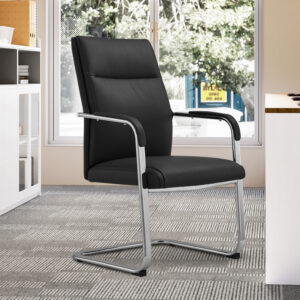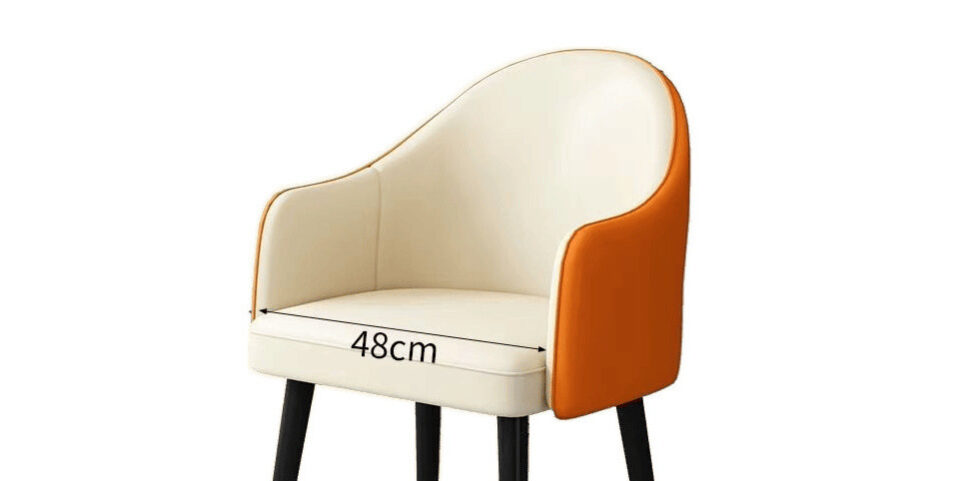An office chair is considered ergonomic when it is specifically designed to support the body’s natural posture, reduce strain, and provide comfort during extended periods of sitting. Here are the key factors that make an office chair truly ergonomic:
1. Lumbar Support
- What It Is: The lower back support in a chair that follows the natural curve of your spine, especially in the lumbar (lower back) area.
- Why It’s Important: Proper lumbar support prevents lower back pain by maintaining the correct alignment of the spine. It supports the natural inward curve of the lower back, ensuring the spine remains in a neutral position and minimizing pressure on the spine’s discs and muscles.
2. Seat Depth and Width
- What It Is: The distance between the backrest and the front edge of the seat, and the overall seat width.
- Why It’s Important: An ergonomic chair should have a seat that supports your thighs without restricting circulation. The depth should allow you to sit comfortably with a few inches between the back of your knees and the seat edge, while the width should be sufficient to allow you to move freely without feeling cramped.
3. Adjustable Seat Height
- What It Is: The ability to adjust the chair’s height so that your feet rest flat on the floor with your thighs parallel to the ground.
- Why It’s Important: Correct seat height promotes proper posture and reduces strain on your legs, hips, and knees. This ensures that you’re sitting in a neutral position that supports the natural curve of your spine and helps with overall circulation.
4. Backrest Tilt and Recline
- What It Is: The ability to adjust the angle of the backrest to suit your body’s natural recline.
- Why It’s Important: A reclinable backrest lets you change positions throughout the day, reducing spinal compression and allowing your muscles to relax. Look for chairs with a tilt tension control so you can adjust how easily the backrest reclines, allowing for dynamic sitting.
5. Adjustable Armrests
- What It Is: Armrests that can be moved up/down, forward/backward, or even side-to-side.
- Why It’s Important: Adjustable armrests help reduce shoulder strain and wrist fatigue by allowing your arms to rest comfortably, with your elbows at a 90-degree angle. This encourages neutral wrist positioning while typing or using a mouse and helps to reduce stress in the neck and shoulders.
6. Seat Cushioning
- What It Is: The material and padding of the seat that provides comfort while sitting.
- Why It’s Important: High-density foam or memory foam seats offer the right balance of comfort and support. The cushioning helps distribute your weight evenly, reducing pressure points on your hips and thighs. A good cushion prevents numbness and discomfort during prolonged sitting.
7. Breathable Materials
- What It Is: Materials used for the backrest and seat that allow for airflow.
- Why It’s Important: Breathable fabrics like mesh prevent overheating and sweating, making long sitting sessions more comfortable. The airflow also promotes better hygiene and reduces the buildup of heat and moisture, especially in warmer work environments.
8. Swivel Function
- What It Is: The ability of the chair to rotate 360°.
- Why It’s Important: Swivel chairs allow for easy movement and accessibility without straining your body. This feature allows you to turn and reach for things around your workspace, reducing the need for constant bending or twisting that could lead to discomfort or strain.
9. Stable Base and Casters
- What It Is: The five-point base and wheels (casters) that allow the chair to roll.
- Why It’s Important: A stable base ensures the chair won’t tip over while you’re sitting. The casters (wheels) enable you to move freely, easily adjust your position, or reach for objects without straining. Chairs with multi-surface casters are ideal for different types of floors (wood, carpet, etc.).
10. Neck and Head Support (Optional)
- What It Is: A headrest that supports the back of your neck and head.
- Why It’s Important: A headrest helps alleviate neck tension and promotes proper alignment of the cervical spine (neck area). It provides support during longer breaks or reclines, reducing the risk of neck stiffness and headaches.
11. Adjustable Tilt Tension and Lock
- What It Is: A mechanism that controls how much resistance there is when leaning back in the chair, as well as the ability to lock the chair in a specific recline position.
- Why It’s Important: Tilt tension allows you to adjust the resistance based on your weight, ensuring that you can lean back comfortably without straining. The lock feature helps you maintain a stable position when you need it, allowing you to focus without worrying about the chair shifting.
12. Ergonomic Design Features
- What It Is: The overall shape and design of the chair, which should align with your body’s natural curves.
- Why It’s Important: A chair that’s ergonomically designed takes into account your spine’s natural curves, ensuring that the seat and backrest promote proper alignment. Contoured seat edges and a curved backrest prevent pressure points and provide support where you need it most.
13. Build Quality and Durability
- What It Is: The overall construction and materials used in the chair, including the frame, fabric, and mechanisms.
- Why It’s Important: A sturdy steel or aluminum frame ensures that the chair remains durable and can support weight over time. The high-quality materials used in construction ensure that the chair will remain comfortable and functional for years, even with heavy daily use.
Conclusion: What Makes a Chair Truly Ergonomic?
An ergonomic office chair is designed to support your body’s natural structure and movements, preventing strain, promoting proper posture, and improving comfort over long hours of sitting. The key factors—lumbar support, adjustable features, breathable materials, and quality build—are what make the chair effective in creating a healthy, productive workspace. If your office chair incorporates most (or all) of these features, it can help keep you comfortable and pain-free throughout your workday.














